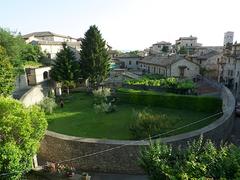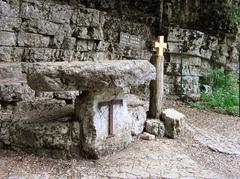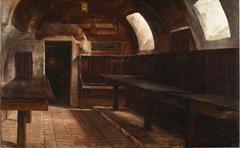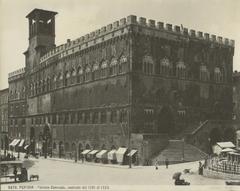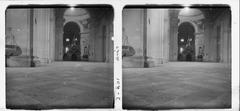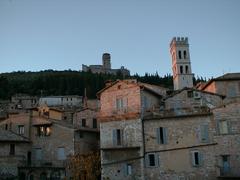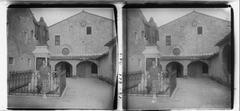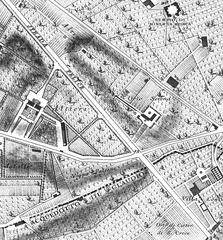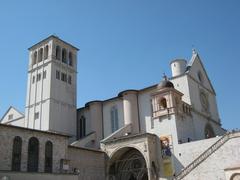
Chapel of Mary Magdalene, Assisi, Italy: Visiting Hours, Tickets, and Historical Sites Guide
Date: 04/07/2025
Introduction: Discovering the Chapel of Mary Magdalene in Assisi
Tucked within the Lower Church of the Basilica of San Francesco, the Chapel of Mary Magdalene stands as one of Assisi’s most evocative spiritual and artistic treasures. This sacred space embodies the Franciscan spirit of humility, compassion, and service to the marginalized—values that shaped the city’s religious history. The chapel, renowned for its early 14th-century frescoes and stained glass windows, commemorates Mary Magdalene, a pivotal figure in Christian tradition renowned for her repentance and devotion.
The chapel’s intimate scale, historical role as a refuge for lepers and penitents, and its exceptional artworks—attributed to Giotto’s workshop and followers—make it a focal point for pilgrims, art lovers, and history enthusiasts. Visiting the Chapel of Mary Magdalene offers a unique opportunity to connect with Assisi’s medieval heritage, Franciscan spirituality, and the enduring legacy of Christian mercy.
For a truly enriching experience, it is essential to be informed about visiting hours, ticketing, accessibility, dress codes, and nearby attractions. This comprehensive guide provides all the practical and historical information you need to plan your visit. For updates and further details, consult the official Basilica of San Francesco website and other trusted resources. (keithparry.org, sanfrancescopatronoditalia.it, fatherkenny.com, The Catholic Travel Guide)
Table of Contents
- Introduction
- Historical Background and Construction
- Artistry and Patronage
- Iconography and Spiritual Themes
- Practical Visitor Information
- Chapel in the Religious and Cultural Landscape of Assisi
- Nearby Attractions
- FAQs
- Conclusion
- References
Historical Background and Construction
The Chapel of Mary Magdalene (Cappella di Santa Maria Maddalena) was established during the early 14th-century expansion of the Basilica of San Francesco. Construction of the Lower Church began soon after St. Francis’s death in 1226, with the Magdalene Chapel likely completed between 1305 and 1319. Its location was chosen both for practical reasons—proximity to the ancient leprosarium—and for its liturgical function as a space for penitents and the marginalized, reflecting deep Franciscan values (keithparry.org, core.ac.uk).
Patronage and Artistic Attribution
The chapel’s creation was overseen by Teobaldo Pontano, the Franciscan bishop of Assisi, whose donor portrait appears in the fresco cycle. Artistic direction is largely attributed to Giotto’s followers, with the vibrant frescoes and stained glass marking a shift toward naturalism and emotional expressiveness in medieval Italian art (core.ac.uk).
Artistry and Spiritual Themes
Iconography and Frescoes
The chapel’s seven fresco scenes vividly narrate Mary Magdalene’s life—her conversion, penitence, and her role as the first witness to Christ’s Resurrection. These stories, together with depictions of saints and angels, serve as both devotional tools and theological exemplars of forgiveness and renewal. The stained glass windows, with eleven narrative scenes and five standing figures, add further visual depth and storytelling power (core.ac.uk).
Theological Significance
Mary Magdalene is celebrated as a model of repentance and witness, qualities central to the Franciscan mission of humility and mercy. The chapel’s ongoing liturgical role, especially on her feast day (July 22), and its historical association with care for lepers and penitents, encapsulate the Franciscan dedication to serving society’s most vulnerable (The Catholic Travel Guide).
Practical Visitor Information
Visiting Hours
- Lower Basilica (including Chapel of Mary Magdalene):
- Winter: 6:00 am – 6:00 pm
- Summer: 6:00 am – 7:00 pm
- 7:00 pm – 8:00 pm: open for prayer only (closed Wednesdays)
- Upper Basilica: 8:30 am – 6:00 pm (winter), 8:30 am – 7:00 pm (summer)
Hours may vary on religious holidays and for special events. Always check the official basilica website before visiting.
Tickets and Admission
- Entry: Free to both the basilica and the Chapel of Mary Magdalene; donations appreciated.
- Audio guides: Available for approximately €6.
- Guided tours: Friar-led and other tours can be booked in advance (The Geographical Cure).
Accessibility
- The basilica has ramps and lifts at certain entrances, but medieval architecture means some areas are less accessible.
- Wheelchair users should contact the basilica in advance for assistance (sanfrancescopatronoditalia.it).
Dress Code and Visitor Etiquette
- Shoulders and knees must be covered.
- Strappy tops, shorts, and sleeveless clothing are not permitted; coverings may be provided if needed.
- Silence is expected; photography and video are strictly prohibited inside the chapel (Maddy’s Avenue).
Guided Tours and Special Events
- Guided tours offer rich insights into the chapel’s history and art. Advance booking is recommended.
- Special liturgies occur on major feast days, particularly for St. Mary Magdalene and St. Francis.
Facilities and Amenities
- Restrooms: Available within the basilica complex.
- Shops: Religious articles and souvenirs can be found at the basilica shop.
- Cafés/Restaurants: Numerous options in Assisi’s historic center.
- Parking: Paid parking outside the city center, with escalators and shuttle buses for access (Assisi Online).
Best Times to Visit
- Early morning (6:00–8:00 am) or late afternoon (after 4:00 pm) for quiet reflection (Earth Trekkers).
- Avoid weekends and major feast days to escape crowds.
- The basilica is busiest around October 4 (St. Francis’s feast) and Easter.
Travel Tips and Safety
- Wear comfortable shoes; Assisi is hilly and cobbled.
- Hydrate, especially during warmer months.
- Bag checks may be conducted at the entrance; keep valuables secure.
Chapel in the Religious and Cultural Landscape of Assisi
The Chapel of Mary Magdalene is part of a rich tapestry of sacred sites in Assisi, including the Basilica of St. Clare, the Cathedral of San Rufino, and the Hermitage of Carceri. Its focus on penance and healing is a complement to the city’s broader legacy of poverty, humility, and peace. Pilgrims often visit the chapel as an act of compassion and solidarity, reflecting centuries-old Franciscan traditions (Regina Tours).
Nearby Attractions
- Tomb of St. Francis (Lower Basilica)
- Upper Basilica with Giotto’s frescoes
- Basilica of Santa Chiara (St. Clare)
- Cathedral of San Rufino
- San Damiano Church
- Carceri Hermitage (short drive/hike from the city)
For a deeper experience, consider combining your visit with these sites, all accessible by foot or local transport (The Catholic Travel Guide).
Frequently Asked Questions (FAQs)
Q: What are the visiting hours for the Chapel of Mary Magdalene?
A: The chapel is open during the Lower Basilica hours, typically 6:00 am–6:00 pm (winter) and 6:00 am–7:00 pm (summer). Always check the official website for updates.
Q: Is there an entry fee?
A: No, entry is free. Donations are encouraged.
Q: Are guided tours available?
A: Yes, including options led by English-speaking friars.
Q: Is photography allowed?
A: No, photography and video recording are strictly prohibited inside the chapel.
Q: Is the basilica accessible for wheelchair users?
A: The complex offers partial accessibility; contact staff in advance for details.
Conclusion
The Chapel of Mary Magdalene in Assisi offers a rare blend of medieval artistry, Franciscan spirituality, and historical resonance. Its frescoes and stained glass windows not only narrate Mary Magdalene’s journey but also reflect the city’s enduring commitment to humility, penance, and service. With flexible visiting hours, free admission, and the availability of insightful guided tours, visitors can immerse themselves in a profound spiritual and cultural experience.
For optimal planning, consult official channels, download the Audiala app for audio guides, and explore related articles on Assisi’s sacred heritage. The chapel’s legacy continues to inspire, inviting all who enter to reflect on forgiveness, renewal, and the enduring power of compassionate faith.
References
- Basilica di San Francesco, Assisi: History and Art, 2022, Keith Parry
- Visiting the Chapel of Mary Magdalene in Assisi, 2024, Father Kenny
- The Franciscan Chapel of Mary Magdalene in Assisi: Artistic and Theological Perspectives, 2023, Core.ac.uk
- Assisi: Italy’s Spiritual Heart, 2023, The Catholic Travel Guide
- Chapel of Mary Magdalene Visiting Hours and Tickets, 2024, San Francesco Patrono d’Italia
- Guide to the Basilica of St. Francis of Assisi, 2023, The Geographical Cure

